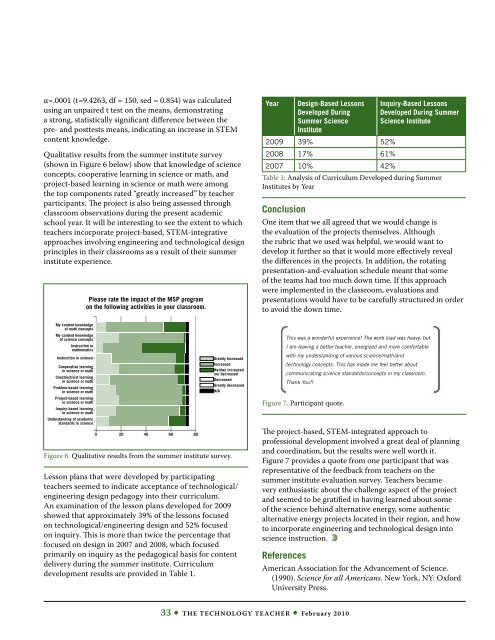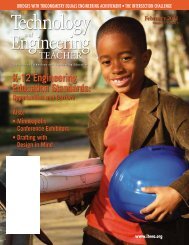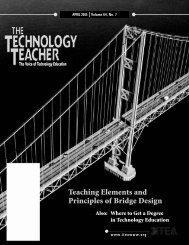February - Vol 69, No 5 - International Technology and Engineering ...
February - Vol 69, No 5 - International Technology and Engineering ...
February - Vol 69, No 5 - International Technology and Engineering ...
Create successful ePaper yourself
Turn your PDF publications into a flip-book with our unique Google optimized e-Paper software.
α=.0001 (t=9.4263, df = 150, sed = 0.854) was calculated<br />
using an unpaired t test on the means, demonstrating<br />
a strong, statistically significant difference between the<br />
pre- <strong>and</strong> posttests means, indicating an increase in STEM<br />
content knowledge.<br />
Qualitative results from the summer institute survey<br />
(shown in Figure 6 below) show that knowledge of science<br />
concepts, cooperative learning in science or math, <strong>and</strong><br />
project-based learning in science or math were among<br />
the top components rated “greatly increased” by teacher<br />
participants. The project is also being assessed through<br />
classroom observations during the present academic<br />
school year. It will be interesting to see the extent to which<br />
teachers incorporate project-based, STEM-integrative<br />
approaches involving engineering <strong>and</strong> technological design<br />
principles in their classrooms as a result of their summer<br />
institute experience.<br />
My content knowledge<br />
of math concepts<br />
My content knowledge<br />
of science concepts<br />
Instruction in<br />
mathematics<br />
Instruction in science<br />
Cooperative learning<br />
in science or math<br />
Constructivist learning<br />
in science or math<br />
Problem-based learning<br />
in science or math<br />
Project-based learning<br />
in science or math<br />
Inquiry-based learning<br />
in science or math<br />
Underst<strong>and</strong>ing of academic<br />
st<strong>and</strong>ards in science<br />
Please rate the impact of the MSP program<br />
on the following activities in your classroom.<br />
0 20 40 60 80<br />
Greatly Increased<br />
Increased<br />
Neither increased<br />
nor decreased<br />
Decreased<br />
Greatly decreased<br />
N/A<br />
Figure 6. Qualitative results from the summer institute survey.<br />
Lesson plans that were developed by participating<br />
teachers seemed to indicate acceptance of technological/<br />
engineering design pedagogy into their curriculum.<br />
An examination of the lesson plans developed for 2009<br />
showed that approximately 39% of the lessons focused<br />
on technological/engineering design <strong>and</strong> 52% focused<br />
on inquiry. This is more than twice the percentage that<br />
focused on design in 2007 <strong>and</strong> 2008, which focused<br />
primarily on inquiry as the pedagogical basis for content<br />
delivery during the summer institute. Curriculum<br />
development results are provided in Table 1.<br />
Year<br />
Conclusion<br />
Design-Based Lessons<br />
Developed During<br />
Summer Science<br />
Institute<br />
Inquiry-Based Lessons<br />
Developed During Summer<br />
Science Institute<br />
2009 39% 52%<br />
2008 17% 61%<br />
2007 10% 42%<br />
Table 1: Analysis of Curriculum Developed during Summer<br />
Institutes by Year<br />
One item that we all agreed that we would change is<br />
the evaluation of the projects themselves. Although<br />
the rubric that we used was helpful, we would want to<br />
develop it further so that it would more effectively reveal<br />
the differences in the projects. In addition, the rotating<br />
presentation-<strong>and</strong>-evaluation schedule meant that some<br />
of the teams had too much down time. If this approach<br />
were implemented in the classroom, evaluations <strong>and</strong><br />
presentations would have to be carefully structured in order<br />
to avoid the down time.<br />
This was a wonderful experience! The work load was heavy, but<br />
I am leaving a better teacher, energized <strong>and</strong> more comfortable<br />
with my underst<strong>and</strong>ing of various science/math/<strong>and</strong><br />
technology concepts. This has made me feel better about<br />
communicating science st<strong>and</strong>ards/concepts in my classroom.<br />
Thank You!!<br />
Figure 7. Participant quote.<br />
The project-based, STEM-integrated approach to<br />
professional development involved a great deal of planning<br />
<strong>and</strong> coordination, but the results were well worth it.<br />
Figure 7 provides a quote from one participant that was<br />
representative of the feedback from teachers on the<br />
summer institute evaluation survey. Teachers became<br />
very enthusiastic about the challenge aspect of the project<br />
<strong>and</strong> seemed to be gratified in having learned about some<br />
of the science behind alternative energy, some authentic<br />
alternative energy projects located in their region, <strong>and</strong> how<br />
to incorporate engineering <strong>and</strong> technological design into<br />
science instruction.<br />
References<br />
American Association for the Advancement of Science.<br />
(1990). Science for all Americans. New York, NY: Oxford<br />
University Press.<br />
33 • The <strong>Technology</strong> Teacher • <strong>February</strong> 2010
















